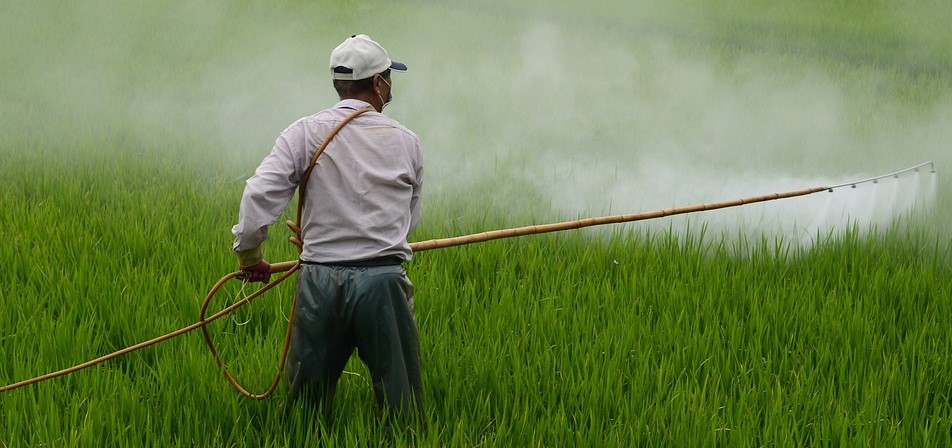Eric Surgarman is a law student at Lewis & Clark Law School and a guest contributor to this blog.
Over 1 billion pounds of pesticides (you read that right, 1,000,000,000 pounds) are applied annually in the United States alone, and with agriculture being responsible for approximately 85-90% of pesticide use, the millions of farmworkers who supply the nation’s food bear the brunt of exposure to these toxic agro-chemicals, with health impacts ranging from the acute (e.g., blisters, vomiting) to the chronic (e.g., Non-Hodgkins lymphoma and other cancers). The Worker Protection Standard (WPS), which the EPA promulgated in 1974 under the authority of the Federal Insecticide, Fungicide, and Rodenticide Act (FIFRA), is the primary regulatory mechanism that addresses the risks associated with pesticide-related illness and injury among farmworkers. The EPA first revised the WPS in 1992 and fully implemented the revisions in 1995. In 2015, the WPS received another make-over when the EPA enacted several revisions to strengthen the protections of the WPS, in part because far too many farmworkers were facing—and continue to face—an unacceptable risk of harmful pesticide exposure.
The 2015 revisions to the WPS included a new provision that requires agricultural employers to keep workers and all other persons, with exceptions (i.e., appropriately trained and equipped handlers), out of an area referred to as the “application exclusion zone” (AEZ) during pesticide applications. The AEZ serves as an essential measure in mitigating farmworkers’ exposure to pesticides, as the threat of harmful exposure is most acute during and immediately after pesticide applications. The AEZ is measured from the point where pesticides are being applied, with the no-entry area essentially encircling the application equipment in all directions. This two-dimensional, circular no-entry area moves with the application equipment (i.e., air blast sprayers, handheld spray-guns, boom sprayers), and remains in effect until the pesticide application has concluded. In some states, like Oregon, the AEZ remains in effect until 15 minutes after the pesticide application has ceased. This temporal extension of the AEZ is superior to the federal standard as it serves to further limit exposure to pesticide drift, since pesticides can remain airborne after application equipment has passed by and applications have ceased.
In November of 2019, the EPA published a proposal to rescind provisions of the 2015 Rule related to the AEZ based on a Trump-era executive order calling on agencies to deregulate where appropriate. During the public comment period that followed the 2019 proposed rule, 126 total comments were submitted on the proposal, of which 110 stood in opposition to rolling back the regulation. Against this backdrop of disapproval, in October of 2020, the EPA still published the 2020 Final Rule, which significantly limited protections for farmworkers and their families. The 2020 Rule would allow, for instance, pesticide handlers to continue spraying pesticides even when workers or other persons were within the area immediately adjacent to or surrounding the application equipment. The rollback was set to go into effect on December 29, 2020. However, the 2020 Rule never went into effect. The United States District Court for the Southern District of New York stayed the rule’s effective date after a coalition of farmworker advocacy organizations brought legal action against the U.S. EPA, challenging the rule. The Court held that the EPA had acted arbitrarily and capriciously in departing from the 2015 Rule and granted the plaintiffs’ motions for a temporary restraining order (TRO) and a stay of the 2020 Rule. Since then, the Court has issued multiple subsequent orders further extending the preliminary injunction continuing the stay of the effectiveness of the 2020 AEZ Rule. The most recent stipulated order was issued on February 16, 2023, and extends the stay of effectiveness through August 22, 2023. The EPA has stated that it plans to update the Federal Register in the event that the stay of effectiveness expires or is lifted, but the Agency doesn’t plan to update the Federal Register with any additional court orders entered to further stay the effectiveness of the 2020 Rule.
In February 2023, the EPA issued a notice of proposed rulemaking that would officially rescind the provisions of the 2020 AEZ Rule that weakened protections for farmworkers and nearby communities from pesticide exposure. The 2023 Rule would reinstate several of the 2015 WPS AEZ requirements and retain some of the 2020 AEZ Rule provisions if finalized. The 60 day period during which members of the public can submit comments on the Agency’s proposed action, referred to in administrative law as the notice and comment period, ran from March 13, 2023 until May 12, 2023. In total, twenty-eight comments were uploaded to the rulemaking docket. Although the public comment period is now closed, the comments remain viewable on the EPA’s rulemaking docket. If the ninth stipulated Order expires on August 22, it will be the first time that an order staying the effectiveness of the 2020 Rule will expire following the conclusion of the notice and comment period for the 2023 Proposed Rule. EPA, therefore, now has the green light to finalize the 2023 Rule and effectively moot the 2020 Rule in doing so. For now, we’re left to wait and see what will become of the AEZ provision of the WPS.
But in the meantime, I’m keeping an eye on the 2023 Farm Bill as another potential pathway towards furthering pesticide protections for farmworkers. Farm bill negotiations are expected to ramp back up when Congress returns from its annual August recess. Congress has the power—and should exercise that power—to require USDA to develop and implement a strategic plan for addressing existing gaps in pesticide protections for farmworkers. This strategic plan could increase USDA’s role in pesticide oversight so that USDA could assist EPA in implementing and enforcing the WPS.
The views and opinions expressed on the FBLE Blog are those of the authors and do not necessarily reflect the official policy or position of FBLE. While we review posts for accuracy, we cannot guarantee the reliability and completeness of any legal analysis presented; posts on this Blog do not constitute legal advice. If you discover an error, please reach out to contact@farmbilllaw.org.


